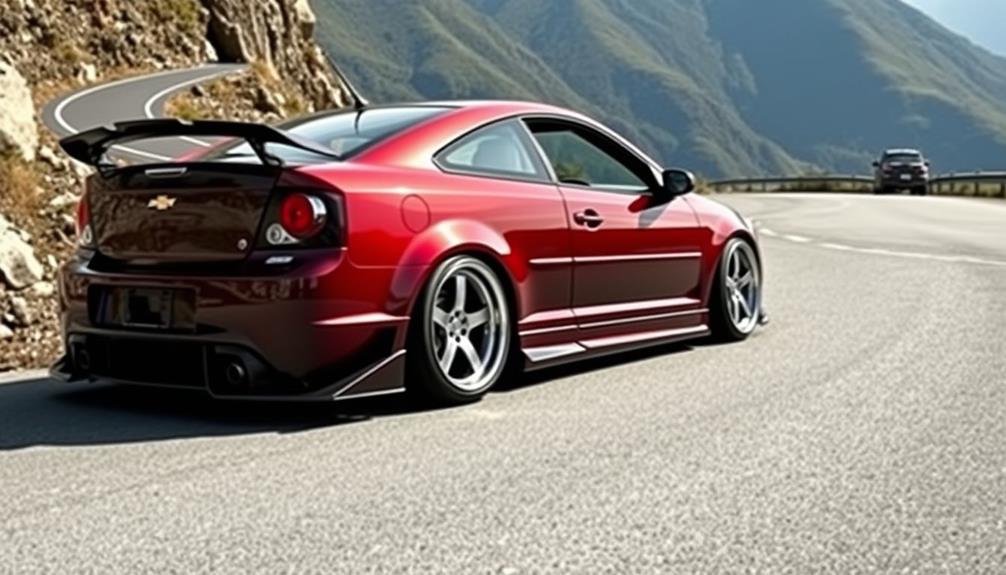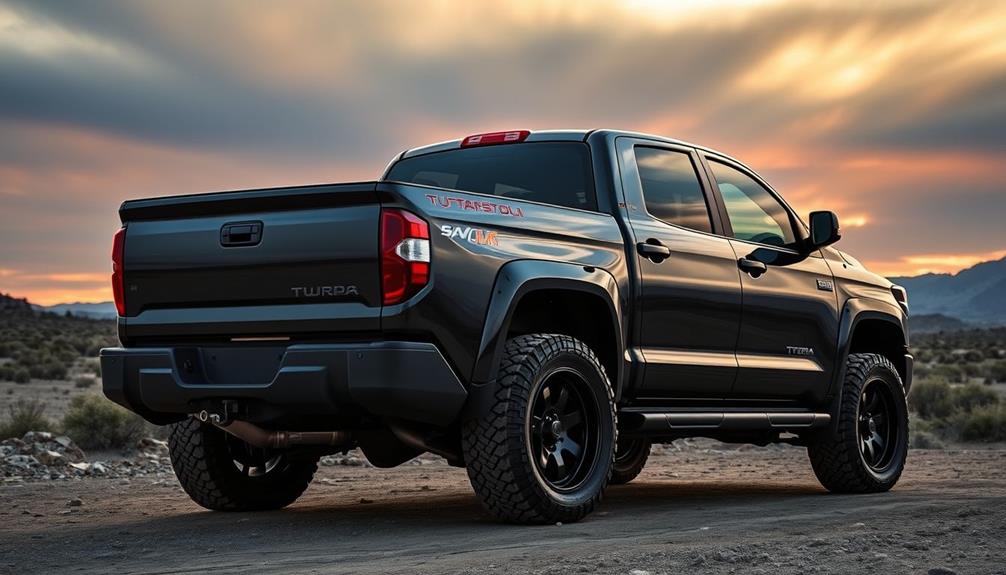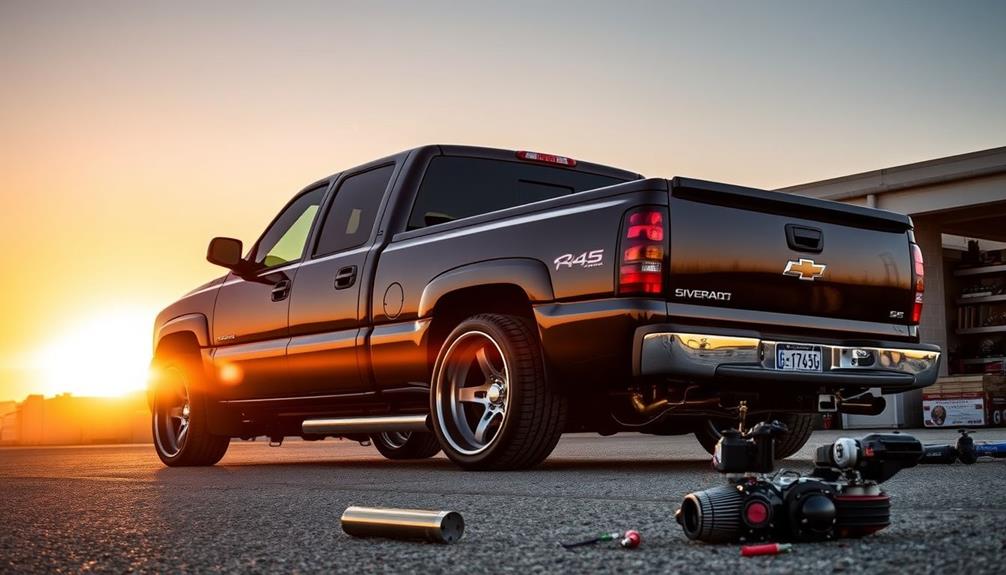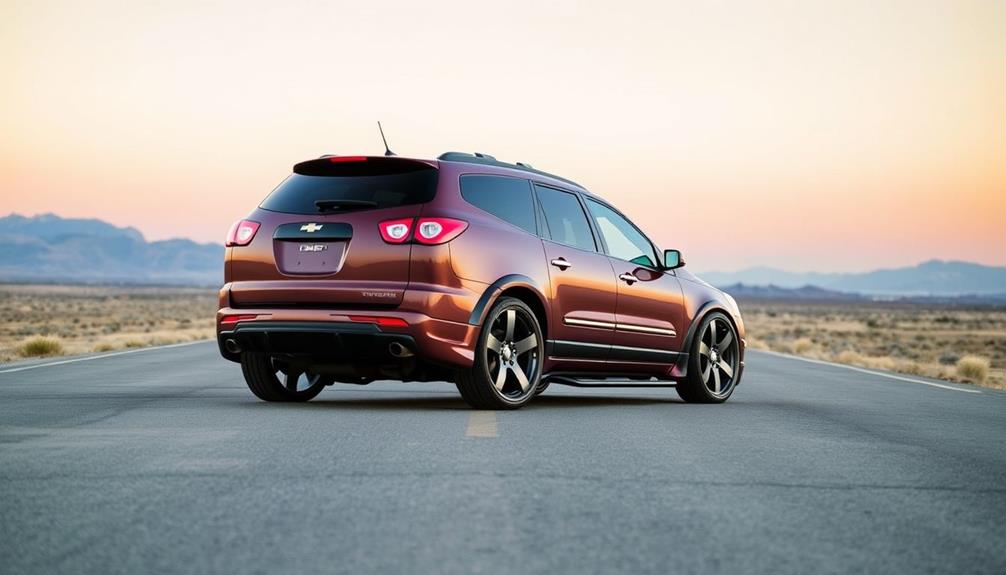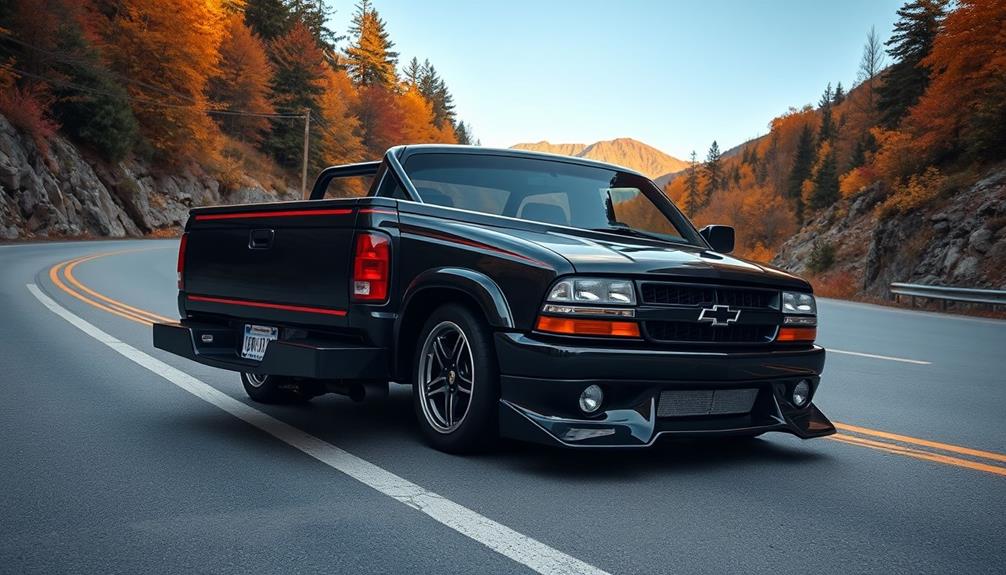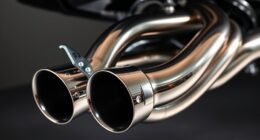To maximize the performance of your Chevrolet Cobalt, start by upgrading components like the cold air intake and throttle body. A clean air filter enhances airflow, while a new intake manifold can greatly boost power. Performance tuning after these modifications guarantees you're getting the most out of your upgrades, adding as much as 45 horsepower. Consider exhaust enhancements, too, like a high-performance manifold or downpipe. Regular tuning adjustments maintain engine efficiency. With the right modifications, you'll transform your sedan into an exciting ride. Stick around to discover more tips and tricks for achieving the best results with your upgrades.
Key Takeaways
- Upgrade to a Cold Air Intake (CAI) for improved airflow, yielding 8-12 HP gains to enhance engine performance.
- Consider a throttle body upgrade, especially to a 2.4L variant, which can add 8-14 HP and improve airflow efficiency.
- Regularly tune your vehicle using software like HP Tuners to maximize power gains from modifications and ensure optimal air-fuel ratios.
- Enhance your exhaust system with high-performance components, such as downpipes and cat-back systems, for additional horsepower and better sound.
- Join online forums and local car clubs to share knowledge and resources for tuning and performance modifications specific to the Chevrolet Cobalt.
Understanding Engine Basics
When it comes to tuning your Chevrolet Cobalt, understanding the engine basics is vital. Your Cobalt may come with several engine options, like the 2.2L, 2.4L, or the powerful 2.0L turbocharged variant. Each engine has unique performance potentials, so knowing what you've got is imperative.
The key factors that influence your engine's power include the ideal mixture of air and fuel, along with precise ignition timing.
Start by verifying your air filter is clean, as a clogged filter can restrict airflow, negatively impacting performance. Upgrading the intake manifold can also enhance airflow, allowing your engine to breathe better and deliver more power.
If you're looking to push your stock Cobalt's power from 254 WHP closer to 311 WHP, consider investing in Performance Parts. Engine modifications, like tuning your fuel system or adjusting ignition timing, can yield significant gains, especially in turbocharged models.
Regular maintenance and a solid understanding of your engine's characteristics will help guarantee reliability and maximize performance after modifications.
With the right approach, you can enjoy an exhilarating driving experience in your Cobalt.
Optimizing Intake and Exhaust
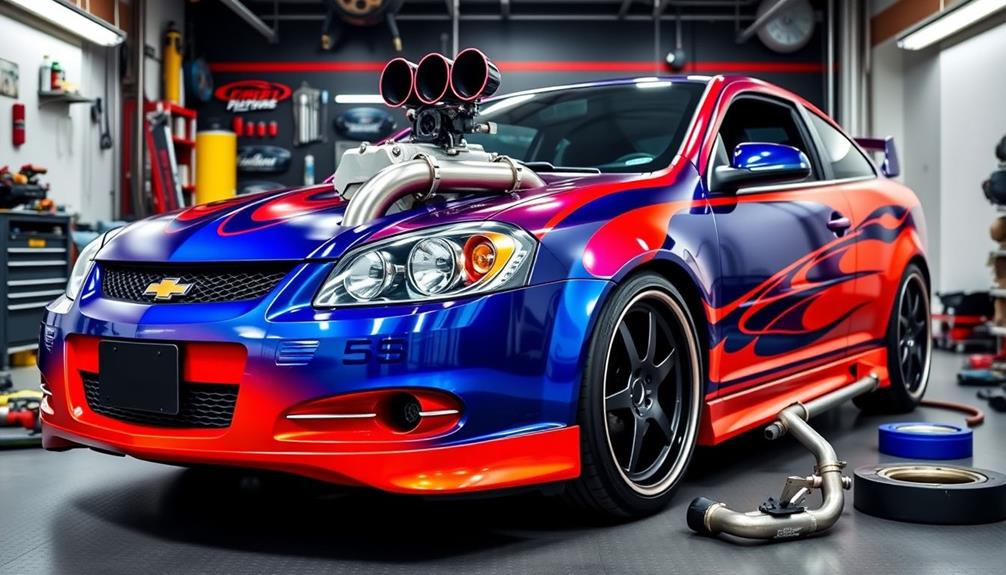
Optimizing your Chevrolet Cobalt's intake and exhaust systems can greatly enhance performance and responsiveness. One of the most effective upgrades is installing a cold air intake (CAI). This modification can boost your horsepower by 8-12 HP by allowing cooler air to enter the engine.
If you're looking for a slightly simpler option, a Short Ram Intake (SRI) can still provide 4-8 HP gains.
Next, consider upgrading your exhaust manifolds. Aftermarket options can reduce restrictions compared to stock, leading to an additional 6-10 HP increase. This enhancement not only improves engine efficiency but also contributes to a sportier sound.
If your Cobalt is turbocharged, adding a performance downpipe can yield another 5-15 HP, considerably improving exhaust flow and turbo spool time.
Upgrading Throttle Bodies
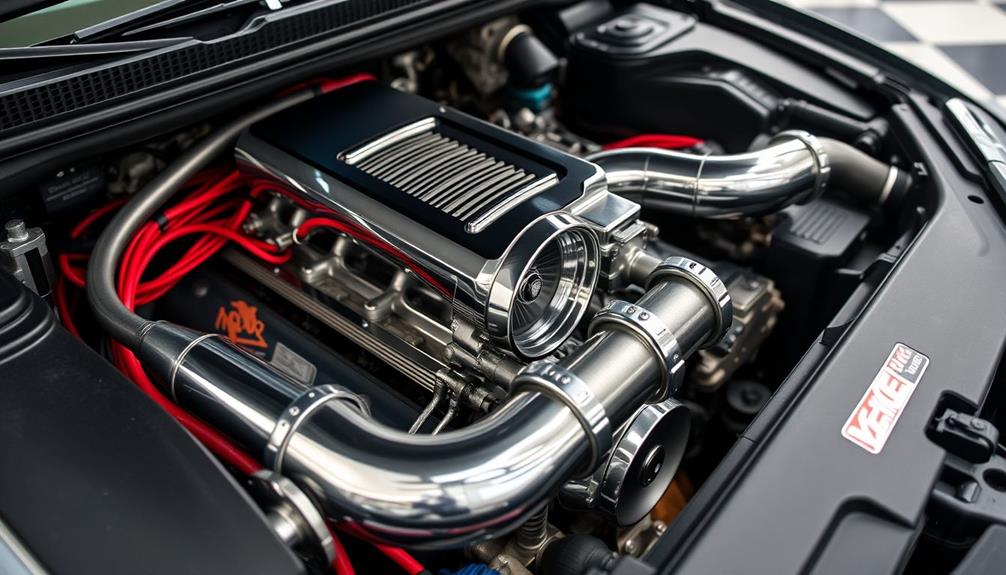
Upgrading your Chevrolet Cobalt's throttle body can greatly enhance engine performance by improving airflow efficiency. By swapping in a 2.4 throttle body, you can gain an impressive 8-14 horsepower, while the 2.0 LSJ throttle body might offer even more, with gains of 10-16 horsepower.
These throttle body upgrades typically focus on enhancing mid to high-range power, but keep in mind that they may reduce low-end torque. That's where proper tuning comes into play.
To maximize the benefits of your throttle body upgrade, you'll need to adjust your spark timing and air/fuel ratios through proper tuning. This step is vital as it helps prevent potential engine damage, ensuring your Cobalt runs smoothly and efficiently after the modifications.
Additionally, a larger throttle body improves airflow efficiency, which is essential if you're planning other performance modifications down the line.
Investing in a throttle body upgrade usually costs between $200-$300, making it a cost-effective way to boost your engine's overall performance.
With the right upgrades and tuning, you'll enjoy a more responsive and powerful ride, transforming your Cobalt into a spirited compact sedan.
Essential Tuning Techniques
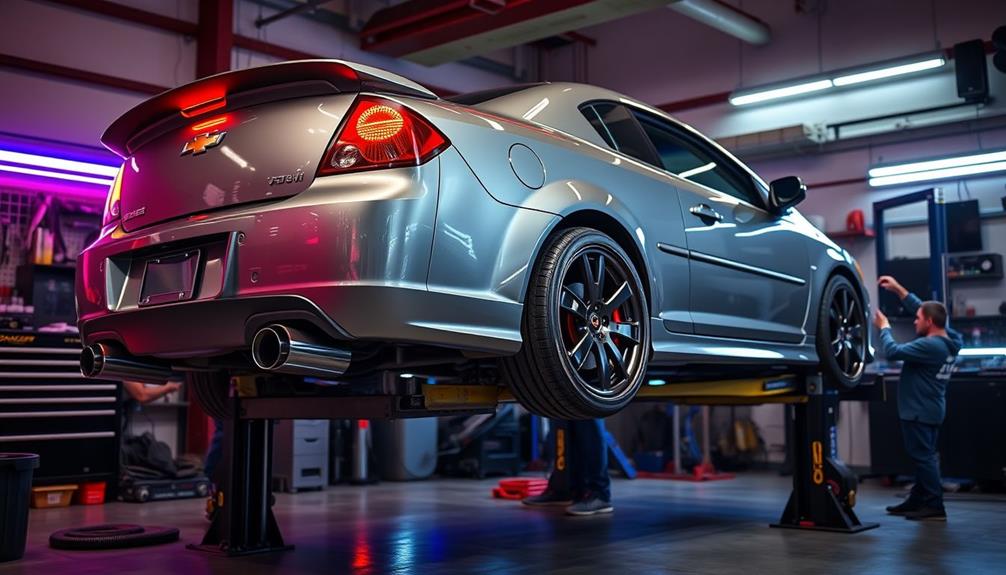
After enhancing your throttle body, fine-tuning your Chevrolet Cobalt is vital for releasing its full potential.
Start by considering a Cold Air Intake (CAI) upgrade. This can boost your horsepower by 8-12 HP by improving airflow with cooler air, typically costing around $200-$250.
With the CAI in place, you should explore performance tuning. A proper tune after throttle body upgrades is essential; a 2.4 throttle body can yield gains of 8-14 HP, while the 2.0 LSJ throttle body can add 10-16 HP when adjusted correctly.
Using HP Tuners, you can achieve impressive results, gaining anywhere from 40WHP to 100WHP, depending on the tune's aggression. If you opt for a Trifecta tune, expect around 35WHP and 70WTQ improvements.
Don't forget about exhaust system upgrades, as they can contribute an additional 5-15 HP from downpipes and 5-10 HP from catback systems, especially when paired with performance headers.
Regular tuning adjustments for air/fuel ratios and spark timing are vital post-modification to optimize engine performance and prevent potential damage.
Keep these essential tuning techniques in mind as you elevate your Cobalt's performance.
Popular Performance Modifications
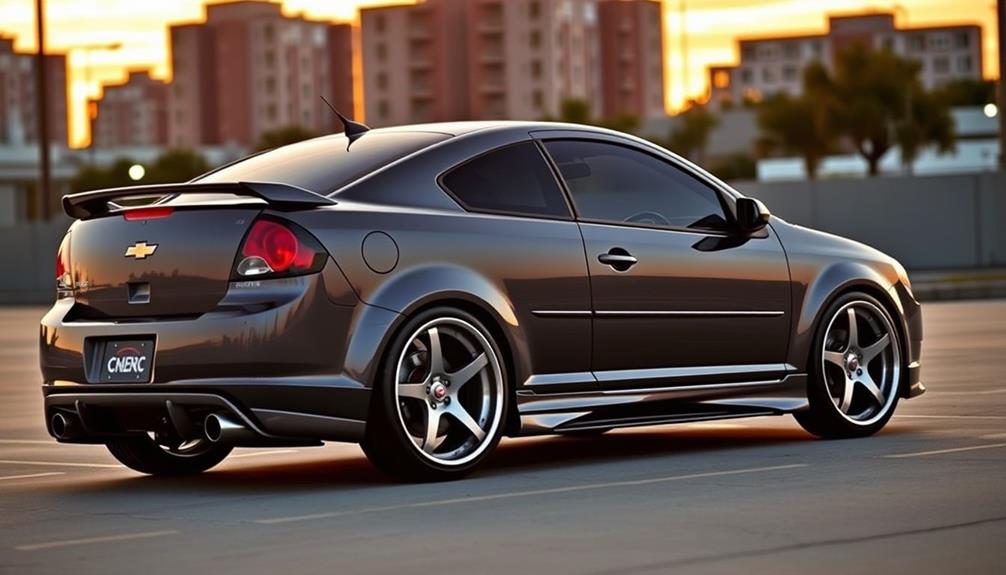
When you're looking to boost your Chevrolet Cobalt's performance, popular modifications like upgrading your intake system and enhancing your exhaust can make a noticeable difference.
Consider installing a cold air intake or a cat-back exhaust system to release extra horsepower.
Don't forget that tuning after these upgrades is essential to maximize your engine's potential.
Intake System Upgrades
One of the most effective ways to enhance your Chevrolet Cobalt's performance is through intake system upgrades. A Cold Air Intake (CAI) can provide gains of 8-12 HP by supplying cooler air to the engine, improving both performance and fuel efficiency.
If you're on a budget, consider a Short Ram Intake (SRI), which typically offers 4-8 HP gains and enhances airflow and throttle response.
You might also want to look into upgrading to a 2.4L intake manifold, which can add an additional 5-10 HP and shift your power band higher for better performance at elevated RPMs.
Aftermarket systems often utilize aluminum tubing, which outperforms stock plastic components in airflow efficiency.
To truly maximize the benefits of these intake system upgrades, proper tuning is key. A ZZP Tune can optimize your air/fuel ratios and spark timing, potentially adding another 12-20 WHP post-modification.
Pairing these upgrades with a high flow cat can further enhance your results. By investing in these modifications, you'll release your Cobalt's potential and enjoy a more exhilarating driving experience.
Exhaust Enhancements
How can you truly release the potential of your Chevrolet Cobalt's performance? One of the most effective ways is by upgrading your exhaust system.
Start with a high-performance exhaust manifold, which can give you a solid boost of 6-10 HP by enhancing exhaust flow. Next, consider installing a high-performance downpipe, providing an additional 5-15 HP and optimizing turbo response.
A catback exhaust system is another popular option, typically yielding 5-10 HP gains. Opt for a durable 304 stainless steel system for improved longevity and performance.
If you're running a naturally aspirated setup, a 2.5-inch exhaust is generally sufficient. However, if you plan on exceeding 400 WHP, a 3-inch system is recommended to avoid back pressure issues.
You can also customize your exhaust sound with components like the Ecotec Shorty Header and resonated catback. These bolt ons allow you to tailor the auditory experience to your liking while enhancing performance.
Tuning Options Available
Upgrading your Chevrolet Cobalt's performance doesn't stop with exhaust enhancements; tuning options can further release its potential.
One of the most popular tuning modifications is the installation of cold air intakes, which can provide 8-12 HP gains by allowing your engine to breathe more efficiently. Pairing this with exhaust upgrades like aftermarket downpipes or catback systems can yield an additional 5-15 HP.
Consider upgrading your throttle body to a 2.4L option for an extra 8-14 HP. After these modifications, performance tuning is essential; using kits like the GM Turbo Upgrade or aftermarket software such as HP Tuners or Trifecta Tune can boost your power by an impressive 30-100 WHP.
Additionally, swapping to a 2.4 intake manifold can give you another 5-10 HP, enhancing airflow even further.
Altogether, a thorough performance upgrade—including these modifications and tuning—can lead to an estimated total gain of 45 HP for around $1050.
With these tuning options, you'll maximize your Cobalt's performance and truly enjoy the thrill of driving!
Community and Resources
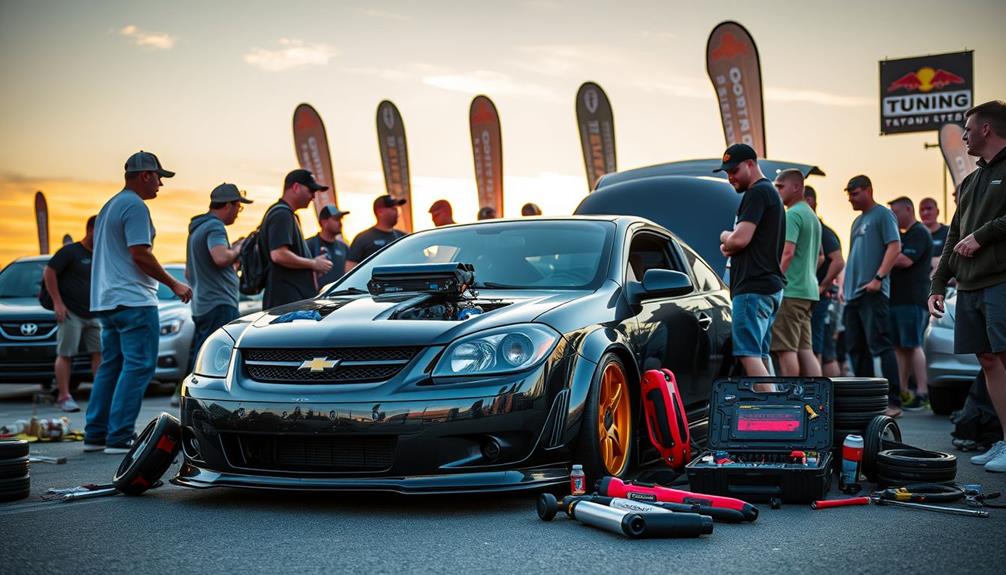
The Chevrolet Cobalt community thrives on a wealth of resources that connect enthusiasts and foster collaboration. Online forums and social media groups are essential for community engagement, offering invaluable advice on tuning, modifications, and troubleshooting. Here, you can ask questions, share your experiences, and learn from fellow Cobalt owners who've successfully completed similar tuning projects.
Local car clubs often host meetups and events, providing a fantastic opportunity to showcase your modifications and network with other enthusiasts. These gatherings create a sense of belonging and encourage you to push your tuning aspirations further.
You'll also find discussions about reputable aftermarket parts suppliers and tuners recommended by community members, ensuring you have access to high-quality components for reliable performance enhancements.
Additionally, user-generated content, such as videos and articles about personal tuning projects, offers practical insights and real-world results. This shared knowledge not only inspires your projects but also helps you stay informed about compliance with local regulations regarding vehicle modifications.
Safety and Compliance
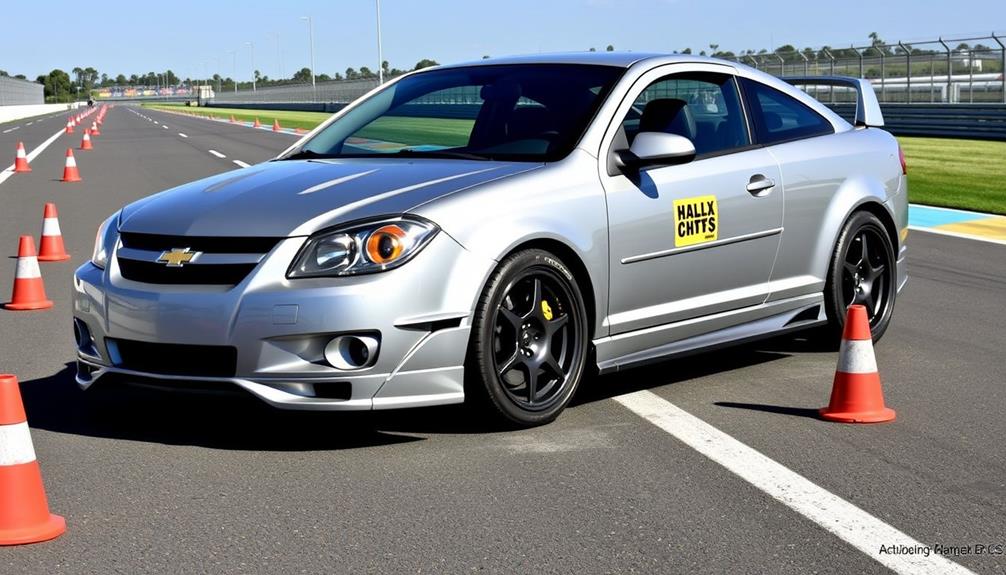
Tuning your Chevrolet Cobalt can be an exciting journey, but it's important to keep safety and compliance at the forefront.
Before making any modifications, consider these vital aspects to guarantee your ride remains roadworthy and within legal boundaries:
- Conduct thorough safety checks after upgrades to verify braking and suspension systems can handle increased power.
- Follow local emissions regulations to avoid fines or potential vehicle impoundment.
- Document all modifications for warranty purposes and future reference, as some performance upgrades may void your warranty.
- Consult your insurance provider before making changes to understand any specific clauses related to modified vehicles.
Investment and Returns
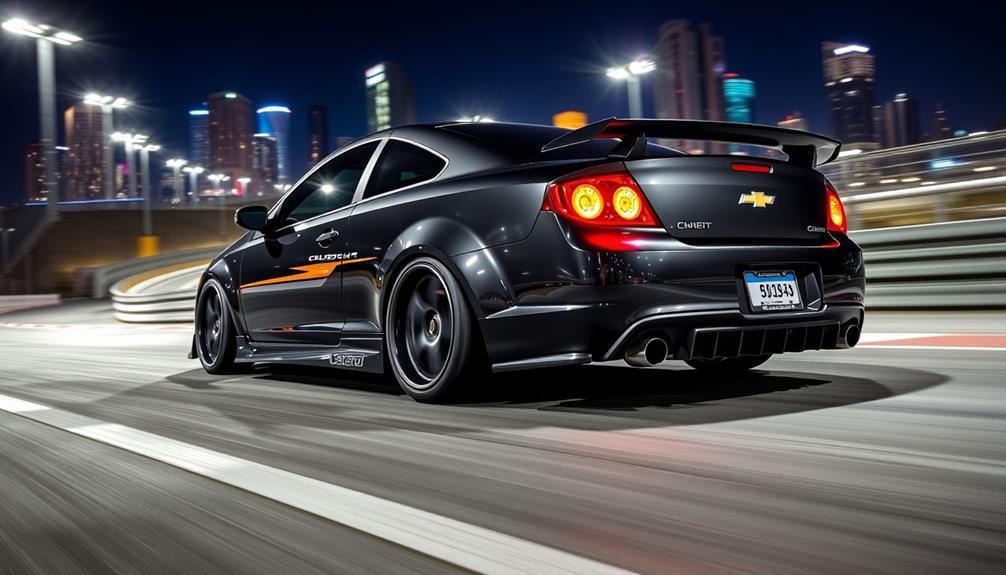
When you consider investing in performance modifications for your Chevrolet Cobalt, understanding the cost versus power gains is essential.
For instance, a cold air intake can boost your horsepower markedly for a reasonable price, providing excellent value.
Additionally, thinking about long-term benefits like improved drivability and reliability can help you maximize your investment.
Cost Vs. Power Gains
Investing in performance upgrades for your Chevrolet Cobalt can yield varying returns in power gains, depending on how much you're willing to spend.
Understanding the cost vs. power gains can help you make informed decisions that suit your budget and performance goals.
Here's a breakdown of some popular upgrades:
- Cold Air Intake (CAI): $200-$250 for 8-12 HP gains ($25/hp).
- 2.4 Throttle Body: $300-$500 for 8-14 HP gains, including tuning costs.
- Performance Tuning: $200-$700 for 12-20 WHP improvements.
- Comprehensive Upgrade Package: Around $1,050 for a total of 45 HP gains.
While some options provide modest improvements, others are more cost-effective for significant HP gains.
For example, forced induction modifications like supercharger kits can deliver around 75 HP for a similar investment.
When choosing upgrades, consider not just the immediate HP gains but also how they fit into your overall performance tuning strategy.
Balancing cost and performance will help you maximize your investment while enjoying a thrilling driving experience in your Cobalt.
Long-term Value Considerations
Long-term value considerations for your Chevrolet Cobalt can greatly impact your investment and returns. Investing in performance modifications can yield significant benefits, like a total estimated gain of 45 HP for around $1,050. This makes it a cost-effective option for enhancing power without sacrificing your car's resale value.
Upgrades such as cold air intakes and exhaust systems not only boost performance but are also popular among enthusiasts, which helps maintain marketability when it's time to sell. Additionally, just as with precious metal investments like Gold IRAs, the right performance upgrades can lead to a better return on your investment over time.
Moreover, engine tuning and modifications can enhance your vehicle's long-term reliability, making it more appealing in the used car market.
To further protect your investment, documenting all performance upgrades and maintenance is essential. This assures potential buyers of the vehicle's upgraded condition and care, preserving its resale value.
Driveability and User Experience

Tuning your Chevrolet Cobalt can transform your driving experience, making it more engaging and responsive.
With the right performance upgrades, you'll notice significant enhancements in driveability, particularly in throttle response and acceleration. Many drivers report a typical increase of around 35-40 WHP and 70-100 WTQ with specific tunes like ZZP or Trifecta.
To maximize your Cobalt's performance, consider these key aspects:
- Throttle Response: Improved tuning allows for quicker reactions, making every drive feel more intuitive.
- Fuel Efficiency: Performance upgrades can also lead to better fuel consumption, an added bonus alongside the power boost.
- Seasonal Adjustments: Tweaking your tune for colder weather can prevent engine issues like detonation.
- Reliability: Regular maintenance and tuning adjustments are essential to sustaining your vehicle's performance and preventing problems.
Frequently Asked Questions
Why Is the Cobalt SS so Fast?
The Cobalt SS is fast because it's powered by a robust turbocharged engine, lightweight chassis, and a well-tuned suspension. These elements combine to deliver impressive acceleration, agile handling, and exceptional overall performance you'll enjoy.
Is a Chevy Cobalt Fast?
Imagine the wind whipping through your hair as you zip down the road. Yes, a Chevy Cobalt can be fast, especially the SS model, with its turbocharged engine that'll leave others in the dust.
Can a Chevy Cobalt Last 300,000 Miles?
Yes, your Chevy Cobalt can last 300,000 miles with proper maintenance. Regular oil changes, timely repairs, and addressing common issues will help you maximize its longevity and reliability, ensuring a long-lasting driving experience.
Is a Chevy Cobalt Considered a Sports Car?
No, a Chevy Cobalt isn't typically considered a sports car. It's classified as a compact sedan, but with the right modifications, it can deliver a sportier experience, especially in SS trim.
Conclusion
In summary, tuning your Chevrolet Cobalt can release its true potential, making your compact sedan a standout on the road. For instance, a Cobalt owner named Jake upgraded his intake system and reprogrammed the ECU, boosting horsepower by 30%. This not only enhanced his driving experience but also turned heads at local car meets. By investing in the right modifications and techniques, you'll enjoy improved performance, handling, and ultimately, a more thrilling ride.
